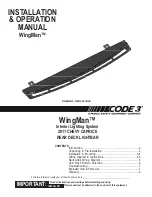
SECTION 10 — PERIODIC MAINTENANCE
10
Periodic Maintenance
GENERAL INFORMATION
To ensure trouble-free vehicle performance, it is very important to follow an established preventive maintenance
program. Regular and consistent vehicle maintenance can prevent vehicle downtime and expensive repairs that can
result from neglect. Any vehicle not functioning correctly should be removed from use until it is properly repaired. This
will prevent further damage to the vehicle and avoid the possibility of injury due to unsafe conditions.
Contact your local Club Car distributor/dealer to perform all repairs and semiannual and annual periodic service.
PRE-OPERATION AND DAILY SAFETY CHECKLIST
Each Club Car vehicle has been thoroughly inspected and adjusted at the factory; however, upon receiving your new
vehicle(s), you should become familiar with its controls, indicators, and operation. Carefully inspect each vehicle to
ensure that it is in proper working condition before accepting delivery.
Use the following checklist as a guide to inspect the vehicle. This checklist should be used daily to ensure that the
vehicle is in proper working condition and in conjunction with the Performance Inspection on page 10-2, and the
Periodic Service Schedules on page 10-4. Any problems should be corrected by a Club Car distributor/dealer or a
trained technician.
Any vehicle not functioning correctly should be removed from use until it is properly repaired. This will prevent further
damage to the vehicle and avoid the possibility of injury due to unsafe conditions.
All Vehicles
•
General:
All the parts should be in place and properly installed. Be sure that all nuts, bolts, and screws are tight.
•
Safety and information decals:
Check to ensure that all safety and information decals are in place.
•
Tires:
Visually inspect tires for wear, damage, and proper inflation on a daily basis.
•
Performance Inspection:
Inspect as instructed.
See Performance Inspection on page 10-2.
Electric Vehicles
•
Batteries:
Check electrolyte to ensure that it is at its proper level
. Check battery posts.
Wires should be tight and free of corrosion. Charge batteries fully before first use of vehicle.
•
Charger cord, plug, and receptacle:
Visually inspect for cracks, loose connections, and frayed wiring.
WARNING
• Be sure the plastic has been removed from the seat bottom before operating the vehicle. Failure to do
so may result in a fire, property damage, personal injury, or death.
Gasoline Vehicles
•
Battery:
Check battery posts. Wires should be tight and free of corrosion and battery should be fully charged.
•
Engine:
Check for proper engine oil level.
•
Fuel:
Check fuel level.
See
. Check fuel tank, lines, cap, pump, fuel filters, and fuel injector for fuel leakage.
2020 Precedent,Villager 2 and 4 Maintenance and Service Manual
Page 10-1
Summary of Contents for DS Villager 4
Page 2: ......
Page 6: ......
Page 481: ...GASOLINE ENGINE HARNESS Wiring Diagrams Gasoline Engine Harness 26 ...
Page 482: ... Page intentionally left blank ...
Page 483: ...GASOLINE MAIN HARNESS Wiring Diagrams Gasoline Main Harness 26 ...
Page 484: ... Page intentionally left blank ...
Page 485: ...GASOLINE INSTRUMENT PANEL HARNESS Wiring Diagrams Gasoline Instrument Panel Harness 26 ...
Page 486: ... Page intentionally left blank ...
Page 488: ... Page intentionally left blank ...
Page 489: ...ELECTRIC MAIN HARNESS Wiring Diagrams Electric Main Harness 26 ...
Page 490: ... Page intentionally left blank ...
Page 492: ... Page intentionally left blank ...
Page 494: ... Page intentionally left blank ...
Page 495: ...ELECTRIC LIGHT HARNESS Wiring Diagrams Electric Light Harness 26 ...
Page 496: ... Page intentionally left blank ...
Page 497: ...ELECTRIC DC TO DC CONVERTER HARNESS Wiring Diagrams Electric DC to DC Converter Harness 26 ...
Page 498: ... Page intentionally left blank ...
Page 507: ...NOTES ...
Page 508: ...NOTES ...
Page 509: ......
Page 510: ......
















































